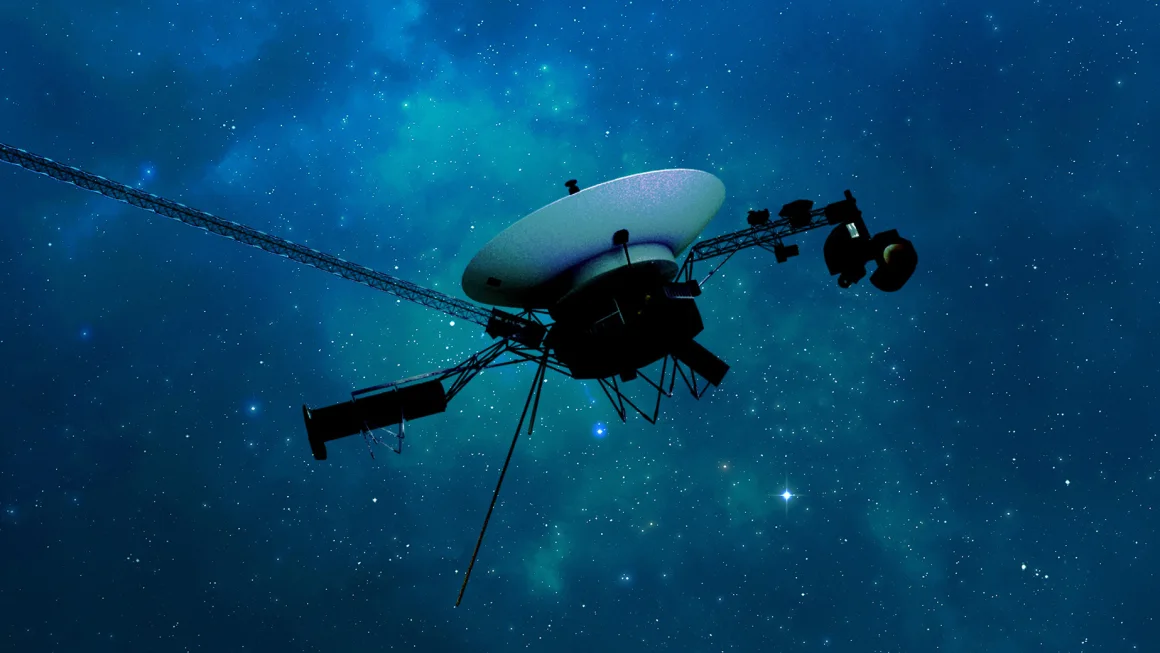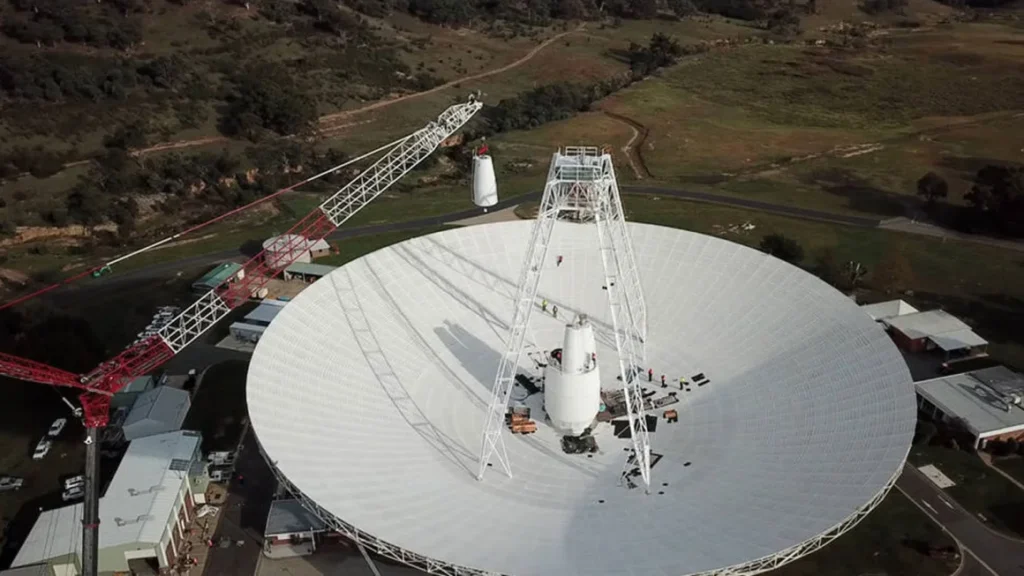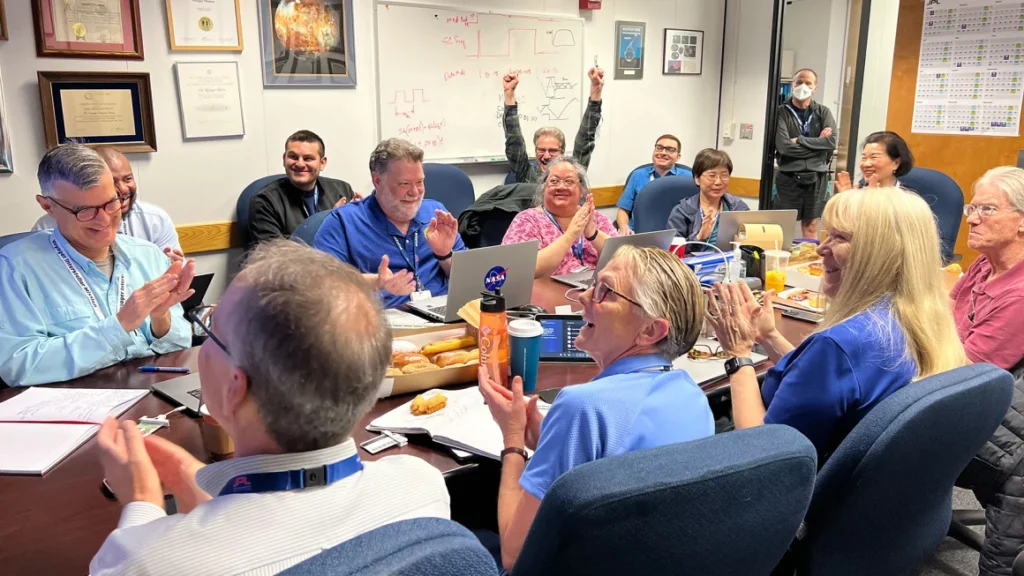NEWS
Voyager 1 Resumes Data Transmission to Earth After Months!

For the first time in five months, engineers realm team NASA have received decipherable data from Voyager 1 after crafting a creative solution to fix a communication problem aboard humanity’s most distant spacecraft in the cosmos.
Voyager 1 is currently about 15 billion miles (24 billion kilometers) away, and at 46 years old, the probe has shown multiple quirks and signs of aging in recent years. The latest issue experienced by Voyager 1 first cropped up in November 2023, when the flight data system’s telemetry modulation unit began sending an indecipherable repeating pattern of code.
Voyager 1’s flight data system collects information from the spacecraft’s science instruments and bundles it with engineering data that reflects its current health status. Mission control on Earth receives that data in binary code, or a series of ones and zeroes.

But since November, Voyager 1’s flight data system had been stuck in a loop. While the probe has continued to relay a steady radio signal to its mission control team on Earth over the past few months, the signal did not carry any usable data.
The mission team received the first coherent data about the health and status of Voyager 1’s engineering systems on April 20. While the team is still reviewing the information, everything they’ve seen so far suggests Voyager 1 is healthy and operating properly.
“Today was a great day for Voyager 1,” said Linda Spilker, Voyager project scientist at JPL, in a statement Saturday. “We’re back in communication with the spacecraft. And we look forward to getting science data back.”
The breakthrough came as the result of a clever bit of trial and error and the unraveling of a mystery that led the team to a single chip.
Voyager 1 Troubleshooting from billions of miles away
After discovering the issue, the mission team attempted sending commands to restart the spacecraft’s computer system and learn more about the underlying cause of the problem.
The team sent a command called a “poke” to Voyager 1 on March 1 to get the flight data system to run different software sequences in the hopes of finding out what was causing the glitch.
On March 3, the team noticed that activity from one part of the flight data system stood out from the rest of the garbled data. While the signal wasn’t in the format the Voyager team is used to seeing when the flight data system is functioning as expected, an engineer with NASA’s Deep Space Network was able to decode it. “NASA discovers city lights”

The Deep Space Network is a system of radio antennae on Earth that help the agency communicate with the Voyager probes and other spacecraft exploring our solar system.
The decoded signal included a readout of the entire flight data system’s memory.
By investigating the readout, the team determined the cause of the issue: 3% of the flight data system’s memory is corrupted. A single chip responsible for storing part of the system’s memory, including some of the computer’s software code, isn’t working properly. While the cause of the chip’s failure is unknown, it could be worn out or may have been hit by an energetic particle from space, the team said.
The loss of the code on the chip caused Voyager 1’s science and engineering data to be unusable.
Since there was no way to repair the chip, the team opted to store the affected code from the chip elsewhere in the system’s memory. While they couldn’t pinpoint a location large enough to hold all of the code, they were able to divide the code into sections and store it in different spots within the flight datasystem.

“To make this plan work, they also needed to adjust those code sections to ensure, for example, that they all still function as a whole,” according to an update from NASA. “Any references to the location of that code in other parts of the (flight data system) memory needed to be updated as well.”
After determining the code necessary for packaging Voyager 1’s engineering data, engineers sent a radio signal to the probe commanding the code to a new location in the system’s memory on April 18.
Given Voyager 1’s immense distance from Earth, it takes a radio signal about 22.5 hours to reach the probe, and another 22.5 hours for a response signal from the spacecraft to reach Earth.
On April 20, the team received Voyager 1’s response indicating that the clever code modification had worked, and they could finally receive readable engineering data from the probe once more.
Exploring interstellar space
Within the coming weeks, the team will continue to relocate other affected parts of the system’s software, including those responsible for returning the valuable science data Voyager 1 is collecting.

Initially designed to last five years, the Voyager 1 and its twin, Voyager 2, launched in 1977 and are the longest operating spacecraft in history. Their exceptionally long life spans mean that both spacecraft have provided additional insights about our solar system and beyond after achieving their preliminary goals of flying by Jupiter, Saturn, Uranus and Neptune decades ago.
The probes are currently venturing through uncharted cosmic territory along the outer reaches of the solar system. Both are in interstellar space and are the only spacecraft ever to operate beyond the heliosphere, the sun’s bubble of magnetic fields and particles that extends well beyond the orbit of Pluto.
Voyager 2, which is operating normally, has traveled more than 12.6 billion miles (20.3 billion kilometers) from our planet. ‘NASA learns the ugly truth about ufos”
Over time, both spacecraft have encountered unexpected issues and dropouts, including a seven-month period in 2020 when Voyager 2 couldn’t communicate with Earth. In August 2023, the mission team used a long-shot “shout” technique to restore communications with Voyager 2 after a command inadvertently oriented the spacecraft’s antenna in the wrong direction.

The team estimates it’s a few weeks away from receiving science data from Voyager 1 and looks forward to seeing what that data contains.
“We never know for sure what’s going to happen with the Voyagers, but it constantly amazes me when they just keep going,” said Voyager Project Manager Suzanne Dodd, in a statement. “We’ve had many anomalies, and they are getting harder. But we’ve been fortunate so far to recover from them. And the mission keeps going. And younger engineers are coming onto the Voyager team and contributing their knowledge to keep the mission going.”
NEWS
Timberwolves’ championship odds improve after three Game 1 upsets

Reading Time: 3 minutes
The second round of the 2025 NBA Playoffs has zagged, and the championship odds of the Minnesota Timberwolves came into sharp focus. This weekend, three of the most powerful and talented squads in the form of the Oklahoma City Thunder, Boston Celtics, and Cleveland Cavaliers were all stunned early as they each dropped their first games of their respective series. All three were heavy favorites — all of them eight-point favorites or more — and all failed to win on their own courts. Those early upsets have further staggering the playoffs and drastically moving betting markets.
The Timberwolves are among the biggest beneficiaries of these results. Their odds to win the championship have certainly improved. Heading into May 2, their odds were, +1700 but after the string of Game 1 upset victories, those odds had improved to +1100. In implied probability terms, that leap means rising from a 5.56 percent likelihood of winning the championship to 8.3 percent, a significant jump in a crowded postseason.
Here are the latest odds for your favorite golfers, with all updated numbers courtesy of FanDuel Sportsbook. The Thunder were +155 and the Celtics were +185 to win the conference prior to the game. The Cavaliers’ odds, meanwhile, held at +500, which means that while they lost, the market isn’t selling them just yet. On the flip side, the Timberwolves, Nuggets and Knicks and Pacers all got a big break. And no team had a swing quite like Denver, which went from +5000 to +1500, the move indicative of more and more of you believing in their ability to cash in the postseason.
This shift in momentum couldn’t be playing out at a worse time for the Timberwolves, who open Game 1 of their Western Conference semifinal series by hosting the Golden State Warriors. Minnesota is favored to win by 6.5 points, and a win would only further solidify their place in the hearts of betting lines and analysts everywhere. The Timberwolves arrived in the playoffs with only the ninth-best championship odds, but their continued presence and the foibles of higher-ranked squads are starting to draw more interest.
Visiting teams winning Game 1 have been a rarity in N.B.A. history, but so far in this round, the victorious Game 1 teams all have been the road teams. The Timberwolves hope to buck it Tuesday night by taking care of their home court. If they can win this series against the Warriors, not only will their series chances appear better, but their long-term championship forecast will get even brighter.
Factor in that part of the drama is the Spurs still not knowing who, if anyone, of All-Star guard Steph Curry would play for the Warriors because of his ailing hamstring. This could even further tilt the scales in Minnesota’s favor for Game 1. And there have been humorous scenes, such as when Warriors forward Buddy Hield arrived at a media session wearing the wrong shorts for Game 1, or when Draymond Green had to walk back his promise not to get suspended, referencing a scuffle he had with the Jazz’s Rudy Gobert.
Though some fans are (understandably) pessimistic regarding the possibility of Minnesota going all the way to the NBA Finals, betting trends and recent performances indicate that they’re becoming a serious force. The team is resilient, recovering from difficult times, and in a better place than most probably thought it would be at this point. Their odds are based on a combination of their strong play and the flaws exhibited by the teams trying to catch them.
Betting odds can and will change and nothing is definitive in the unpredictable world of playoff basketball, but it’s actually evident that as much as they’re not a favorite just yet, Minnesota is no longer viewed as a long shot. They have gone from under-the-radar contenders to legitimate threats, and if they can keep up this level of play, a deep postseason campaign, or even a title shot, no longer sounds like just a pipe dream.
And as the playoffs move forward, it will be interesting to see, regarding both fans and bettors, just how closely people are watching the Timberwolves, who are suddenly a team generating a lot of interest. Their story just keeps getting better and better every game, and the numbers are finally starting to reflect what could be an earth-shattering moment for the franchise.
NEWS
Kohl’s just fired its brand new CEO for unethical behavior

Reading Time: 3 minutes
Kohl’s Kohl’s has had headline-grabbing shareholder activism that included the abrupt ousting of its C.E.O., Ashley Buchanan, only months into the job. He is leaving as the company reels from accusations of unethical behavior that have jolted the business and prompted larger questions about how accountable leadership is and about corporate oversight. Buchanan, who was hired as its chief executive in January 2025, had been meant to help right the ailing department store chain. Instead, he is departing under a cloud of scandal after an internal investigation found that he broke serious rules of the company during his time in charge.
The company said it had fired Buchanan “for cause,” an unusual and major decision in the corporate realm. An outside investigation determined he had ordered the company to engage in transactions with vendors that presented undisclosed conflicts of interest. In simpler language, he was using his role to help conduct business that could have profited him or close associates, without informing the company. The company said that these actions did not involve Kohl’s financial reporting or other employees, but a decision to fire a chief executive just months into the job is also one with outsize implications.
Previously, Buchanan was the CEO of arts and crafts retail chain Michaels. His appointment had been hailed as a bold move to help turn around Kohl’s, which is struggling amid weakening sales and mounting competition in a challenging retail landscape. Yet his stint in office was also followed by further reversals. According to a review of preliminary financial results from Kohl’s, the company’s sales declined by 4.3 percent during his brief time on the job — far short of the turnaround that shareholders were looking for.
The company’s board of directors has named Michael Bender, the current chairman, interim CEO as they search for a new permanent CEO. But the market actually applauded the departure of Buchanan, it surprisingly rose. Shares in Kohl’s jumped as much as 8 percent after the announcement, indicating that investors may have already lost faith in his leadership or are hopeful that new leadership can turn the company around.
Retail analysts are less sanguine. The firing comes as a distraction for the company at a particularly bad moment, said Neil Saunders, managing director at GlobalData Retail. “While the dismissal may have nothing to do with overall company performance, it does add to the perception outside the company that things are a bit shaky. Saunders said it was a “blow upon a bruise,” meaning the move exacerbates already existing problems instead of addressing them.
Like many traditional department stores, Kohl’s has been under extreme pressure in recent years. Shifting consumer tastes, the rise of online shopping and persistent inflation have made it difficult for brick-and-mortar companies to stay profitable. On top of Western leadership woes, the company also is facing the reality of declining foot traffic and ever-more price-sensitive shoppers.
Earlier this year, Kohl’s also shared plans to shutter 27 locations in the U.S. These closures have brought the company’s total store count to about 1,100, representing a significant reduction in the retailer’s store footprint. The move is part of a broader shift in the industry, in which many legacy retailers are rethinking their physical footprints as they try to adjust to a more digital economy.
The repercussions of Buchanan’s firing could be widespread. For Kohl’s, they raise questions of how closely executives are scrutinized and what kinds of internal controls should exist to keep similar problems from happening in the future. For shareholders, it casts further doubt on the direction of the company and questions about who is leading. For the general business public, the case should stand as a reminder that not even top brass is immune from examination and answerability.
The road that lies ahead for Kohl’s is unclear. With interim leadership now secured and a search for a CEO underway, the company needs to move fast to win back the trust of investors and navigate a new course. The scandal is an unnecessary wrinkle to an already difficult environment and who knows, maybe the company does come out stronger. Or maybe this is just another chapter in its struggles.
NEWS
Dwayne Johnson, is that you? See his dramatic new look as UFC fighter Mark Kerr in ‘The Smashing Machine’ trailer

Reading Time: 3 minutes
Dwayne Johnson is stepping into what may be the most transformative role of his acting career, taking on the part of legendary UFC and MMA fighter Mark Kerr in the upcoming film “The Smashing Machine.” This gritty biographical drama, set to release on October 3 and directed by Benny Safdie, offers a deep dive into the life of Kerr—an athlete whose raw physical power in the ring was matched only by the personal demons he battled outside of it. Known widely for his blockbuster action roles, Johnson’s portrayal here marks a significant and deliberate shift toward more dramatic, character-driven storytelling.
In the newly released trailer, Johnson is almost unrecognizable. Though he hasn’t publicly addressed his physical transformation in great detail, it’s apparent that facial prosthetics and careful styling have helped him bear a striking resemblance to Kerr. The fighter’s story, originally featured in the 2002 HBO documentary also titled “The Smashing Machine,” captured the brutal realities of early MMA competition and revealed Kerr’s struggles with substance abuse and emotional turmoil. Johnson appears to embrace every layer of this complexity, channeling the vulnerability and intensity that defined Kerr’s life both inside and outside the ring.
The trailer provides glimpses of the brutal, adrenaline-charged world of professional fighting—raw and visceral in its execution—but it also reveals a far more intimate narrative. Central to this is Kerr’s relationship with his girlfriend, played by Emily Blunt. Reuniting with Johnson after their time together in Disney’s “Jungle Cruise,” Blunt brings a grounded emotional presence to the film. The tension between their characters, caught between love, ambition, and addiction, adds an essential human depth to the story.
In one poignant moment in the trailer, Johnson’s Kerr reflects on the intoxication of success, saying, “Winning is the best feeling in the world. It’s 40,000 people in there cheering you on. There’s no other high like it in the world.” This line encapsulates the highs and lows Kerr experiences as he navigates fame, pain, and a relentless pursuit of victory. Johnson’s delivery is full of gravitas, suggesting a layered performance that digs much deeper than anything he’s previously taken on.
For Johnson, this role is not just a creative departure but a personal challenge. In an interview with GQ last year, he shared that the opportunity to portray Kerr felt like a chance to break new ground in his career. “It was also an opportunity for me, I realized, to stretch myself in ways that I hadn’t been stretched yet,” he explained. “And also challenge myself in ways that I hadn’t been challenged.” That drive to evolve, both as an actor and a storyteller, is evident in every frame of the trailer.
While Johnson has been busy in other areas—voicing Maui once again in “Moana 2,” returning to the WWE ring, and joining the board of TKO Group Holdings following the WWE-UFC merger—“The Smashing Machine” stands apart as a pivotal moment in his career. It’s not about larger-than-life action heroes or comedic charm. It’s about stepping into someone else’s pain and perseverance, and doing so with authenticity.
Director Benny Safdie, making his solo debut after co-directing acclaimed films like “Uncut Gems” with his brother Josh, brings a raw, almost documentary-style realism to the project. His past work has been praised for its tense, emotionally charged storytelling, and “The Smashing Machine” appears to follow in that tradition. The film is likely to appeal not only to fans of MMA and biopics but also to those interested in the psychological complexities that come with public glory and private battles.
As anticipation builds for the release, “The Smashing Machine” seems poised to redefine what audiences expect from Dwayne Johnson. Known affectionately as “The Rock” by his wrestling fans, Johnson is now forging a new path—one that embraces nuance, hardship, and a kind of storytelling that doesn’t rely on spectacle alone. If the trailer is any indication, his turn as Mark Kerr could be one of the most powerful performances of the year.
With a compelling cast, a gripping true story, and a fearless lead performance, “The Smashing Machine” might not just be a film about fighting—it could be a knockout moment in Johnson’s cinematic journey.
-

 Health Care2 years ago
Health Care2 years ago7 Surprising Ways to Lower Cholesterol Naturally – No Medication Needed
-

 Health Care2 years ago
Health Care2 years agoPink Eye(Conjunctivitis): What Is Commonly MISDIAGNOSED As PINK EYE?
-

 Celebrity1 year ago
Celebrity1 year agoRelationship Lessons from Jennifer Lopez and Ben Affleck
-

 Entertainment2 years ago
Entertainment2 years agoZendaya Opens Up About Racy Scenes and Family Reactions in New Film
-

 Entertainment1 year ago
Entertainment1 year agoAustin Abrams Discusses ‘Wolfs,’ Future Projects, and ‘Euphoria’ Season 3
-

 NEWS2 years ago
NEWS2 years agoIs Trump Going To Jail? Your Questions About Trump’s Trial Answered
-

 Entertainment2 years ago
Entertainment2 years agoZendaya and Tom Holland kiss at The London Challengers premiere.
-

 Entertainment2 years ago
Entertainment2 years agoChris Martin and Dakota Johnson reportedly got engaged years ago
















